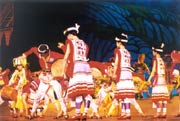Red Lines Embroidered on Trousers Legs & Seal Patterns on Garments' Back  White Trouser Yao, who live in Nandan County, Guangxi Zhuang Autonomous Region, is a special branch in the Yao nationality. Apart from their differences in religious beliefs, customs and conventions from other branches of the Yao nationality, they are also unique in their dresses and adornments. White Trouser Yao, who live in Nandan County, Guangxi Zhuang Autonomous Region, is a special branch in the Yao nationality. Apart from their differences in religious beliefs, customs and conventions from other branches of the Yao nationality, they are also unique in their dresses and adornments.
The most unique feature of men's garments is their "white trousers". They are pure white, knee-length knickerbockers, which are overhanded with blue cloth at the end of the trousers. And five palm-like red lines, which are longer in the middle and shorter at the sides, are embroidered above the blue cloth in the front part of the trousers. Legend has it that the ancestors of the White Trouser Yao originally lived in Jincheng River area, near today's Hechi. One day the tyrannizing ruler Mo sent troops to attack the Yao people in order to rob their beautiful homeland. The King of Yao people immediately gathered the whole village to defend their land. But they were outnumbered by the enemies so greatly that they suffered severe losses and had to leave their homeland to the remote mountains in the southwest. Finally they arrived at today's Yao village (a place in Fangdan). The Yao village mountain at that time was rugged, desolate and dense with trees. The sharp contrast between their beautiful homeland in the memory and the present bleak picture make all the people feel extremely sad and they couldn't help crying. The King of Yao people, exhausted from fight all those days, fell asleep soon after he sat against a big rock on the mountain. Suddenly he found an old man coming to his front and saying, "this is a good place. It has mountains and rivers. There are birds and beasts in the mountains and you can hunt. There are rivers to irrigate the crops. Fairly soon this place will become your beautiful homeland." Suddenly seeing the light, the King of Yao clapped his bloody hands against his knees and yelled, "Good idea." However, it turned out this was nothing but a dream. Yet he was greatly inspired by the dream. Looking around, he found out it was really a good place. So he gave order to the troops to pitch a camp right there and settle down. But the five bloody finger marks on his white trousers, which had been torn apart from the knee down by the thorns could not be removed. In memory of the King, the Yao people later began to make knickerbockers based on the trousers that he was wearing at that time and embroidered five red lines just above the knees. This tradition is well kept till now.
The most famous women's dresses are the so-called "hanging" garments. Both the front and back of the garment are two complete cloths linked together in the shoulder with a black cloth of about 10 centimeters wide. It is collarless, sleeveless and the armpits are not sewed together. The two cloths naturally fall on the breast and back when the garment is pulled over from the head down. Interestingly, most of these garments are embroidered in the back with colored threads a pattern similar to a square seal. The legend goes like this: the King of Yao people, according to the customs and conventions of the Yao people, published a notice seeking for a handsome son-in-law. He succeeded in finding one and the next year a loveable grandson was born. The King was very happy. In order to amuse his grandson, he always took out the wooden box containing the seal of the Yao people for his grandson to play with. Yet it never occurred to him that his son-in-law was nobody but the son of the ruler Mo, who had been coveting the Yao village. Later it turned out that he gained the King's trust, stole the seal away and attacked the Yao village. Without the seal the King failed to assemble the troops from other Yao villages and eventually he lost the battle. Later, in order not to forget their hatred for Mo and also to remember the seal of the Yao people, the women began to embroider a seal pattern on the back of their garments.
This legend is not completely made up, reflecting how the Mo ruler plundered, exploited and oppressed Yao people and how they rose up courageously to fight back.
Slash-and-burn Cultivation and Migration <<
Panyao Three-horned Hat Scares Tiger Away >>
|